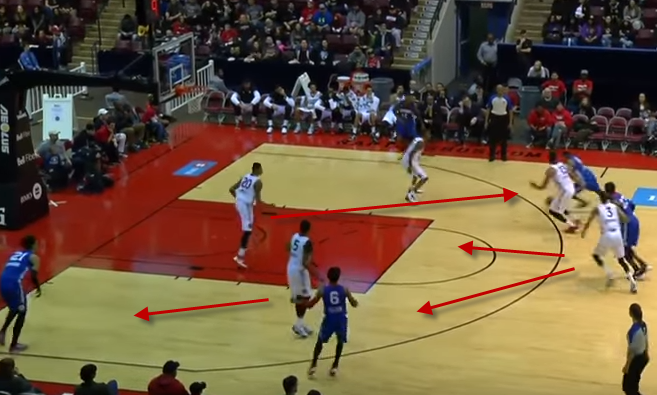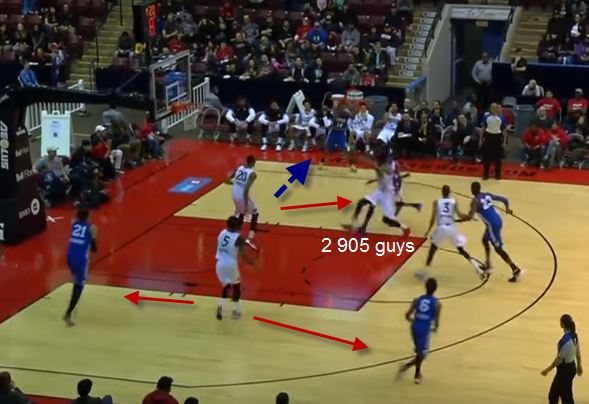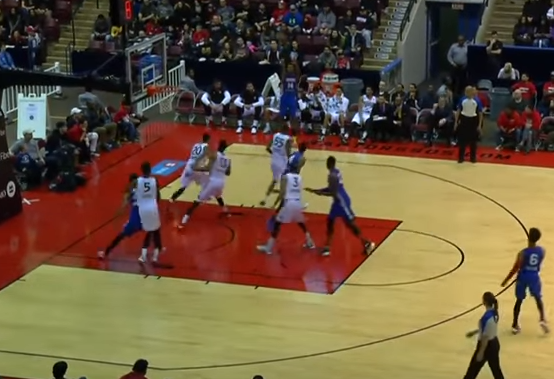When the Toronto Raptors selected Delon Wright with the No. 20 pick in the draft, the term “NBA ready” got thrown around some, to the point that there was moderate surprise when the Raptors followed up by signing Cory Joseph to a four-year, $29.9-million deal that bumped Wright to “PG3” on the depth chart.
The term “NBA ready,” as it pertains to most picks, is a misnomer. Few rookies are ready to contribute at the NBA level, and freshman by and large struggle to make the jump. There are exceptions, but teams shouldn’t have high initial expectations for the 20th pick, even if it’s a 23-year-old senior. But it was believed that thanks to his intelligent play, smart decision-making, size for the point, and general defensive aptitude, he could figure in as a back-up point guard right away.
It may have confused some, then, when Wright played 10 minutes over the season’s first month and was subsequently assigned to Raptors 905 of the D-League. Joseph has been exceptional in his bench role, Kyle Lowry is capably handling a large minutes load again (for now), and head coach Dwane Casey has opted to keep his rotation tight. With Wright not playing at the NBA level, the assignment made sense, as he quickly racked up 75 minutes of playing time in two games before getting recalled on Sunday.
Wright showed some encouraging signs in his two games with the 905, especially on the offensive end. His vision is unparalleled at that level, and his amoebic dribbling makes him a difficult check and a regular at the free-throw line. There were few nits to pick about how he handled himself with the ball in his hands. But Wright’s defensive performance, thought to be his ticket to early NBA playing time, was imperfect. If anything, it was thought that the speed of the game on offense may be the more difficult transition for him, but – and this is a risky extrapolation from two D-League games that may not be indicative of his practice performance at the NBA level – he appears to still be nailing down the intricacies of a more complex NBA defensive scheme.
In writing his scouting report while I was still with theScore, I wrote that “Wright’s size is a huge asset, and while he needs to fill out more, his length is great for the point and – along with his high effort and sharp anticipation – should make him a quality defender and dangerous ball hawk.” In a far more detailed scouting report after Summer League here at Raptors Republic, I wrote the following:
The same timing and anticipation he shows driving and passing manifests itself on defense. “Feel for the game” is a tough thing to describe and capture, but Wright decidedly has it. His ability to read the play leads to a lot of his steals – he’ll get some on the ball, too, but he also takes calculated gambles when he sees a player starting to pick up his dribble with the ball unprotected, or the opportunity to jump a passing lane arises. The latter particularly applies in the backcourt, where he’s a hawk on inbound plays like that annoying friend in 2K.
With anticipation and intelligence high on his list of strengths, the small mistakes he made over two games serve to prove not only that the term “NBA ready” should be buried because the jump in level of play is so extreme, but also that the D-League is invaluable. NBA practices may be intense, but things look a lot different when they come within the confines of an actual game played at full speed.
Two small areas Wright struggled in are understandable ones, but they’re worth a closer look.
Icing the side pick-and-roll
Among the changes the Raptors made to their defensive system this offseason was a change in approach for handling side pick-and-rolls. Last season, the Raptors welcomed ball-handlers to the middle of the floor as a matter of strategy, far more than any other team in the league. Here’s what that looked like:
This time around, the Raptors are doing what far more teams do and icing (or blueing, or downing) the side pick-and-roll. Tom Thibodeau’s Chicago Bulls did this to great effect, and Andy Greer, a veteran of that system, joined Casey’s staff this offseason. Icing tasks the player guarding the ball-handler to prevent them from using the pick, angling off their path to the middle of the floor and forcing them baseline. The sidelines work as an extra defender, and the idea is to give the ball-handler less space and more difficult passing options while eating away at clock if the team needs to reset up top.
The logic is sound, and John Schuhmann of NBA.com found that offenses score worst in the pick-and-roll when iced.
This is an imperfect example, but DeMarre Carroll illustrates here what icing looks like:
Here’s a better example, with Bismack Biyombo playing the big man role in the ice expertly:
Icing may be somewhat new to Wright. I couldn’t find many good examples of him defending side pick-and-rolls with Jakob Poeltl at Utah last season, but I also wasn’t willing to invest a ton of time into it. Poeltl’s skill set suggests, to me, that the Utes would have been well-served icing, but college defenses are generally less complex and they may have played the side more straight-up.
In any case, it’s something Wright struggled with a bit in his first game with the 905.
[gfy]YearlyConsciousIlladopsis[/gfy]
[gfy]LargeDimpledBuck[/gfy]
In the first example, Wright neglects to ice at all, and in the second he telegraphs an angle that is too vertical long before the pick comes, allowing Brandon Fields to jump the seam before Ronald Roberts realizes what’s happening.
“The only thing I would have liked to see him do better in that game was defend side pick-and-rolls,” head coach Jesse Murmuys said after Wright’s 9-of-9 debut. “We’re forcing down, and coach Casey is going to want him to be able to keep the ball on the sideline. That’s something that we could be better at.”
He did a better job of this against the 87ers on Sunday – the Sevens use a great deal of drag screens on the side, and the fact that none stood out as Wright misplays is encouraging – though that match-up turned into a disaster for the entire team defense late, with downing the sides the least of their concerns.
[gfy]AmusingResponsibleGuineapig[/gfy]
“We did a better job of keeping the ball on the side and now the second piece is trying to force tough twos out of it,” Murmuys said after Sunday’s loss.
Helping off the ball
At Utah, Wright was the primary defender on the ball-handler most of the time. With the length to guard multiple positions and his status as the team’s top perimeter stopper, he didn’t spend as much time off the ball. That showed on a key possession late Sunday, as Wright, playing off the ball, incorrectly helped out of the strong-side corner, leaving the red-hot Sean Kilpatrick wide open for a triple.
[gfy]TediousUnderstatedAfricanaugurbuzzard[/gfy]
The desire to help in that situation is understandable, but the Raptors, as a matter of principle, try not to help off of the strong-side corner. The pass is too easy for the ball-handler to make when the shooter is that close, and there are too few bodies on that side of the floor in a position to rotate and close out.
On this particular play, the rotations called for Wright to stay, because Bruno Caboclo had the help on the drive. If Caboclo slid over to help, the 905 had Scott Suggs in a position to close out on either of two shooters or pick up the weak-side corner on a cut to the basket, and Melvin Johnson would have been responsible to rotate from the top on any subsequent pass outside.

Instead, Wright helps unnecessarily. Caboclo is left guarding nobody, and he can’t close on Kilpatrick in the event Jordan McRae, the ball-handler, gets to the rim through the double.

Had Wright stayed on Kilpatrick, maybe McRae’s foray to the rim is successful, maybe it’s not. The 905 are covered everywhere else on the floor, and once McRae kicks the ball out, there’s nobody to close out.

A contested shot at the rim is preferable to an open corner three, according to the organization’s defensive philosophy.
“That was a young player making a very big mistake,” Mermuys said Sunday. “That first one is Delon Wright helping off the strong side corner, which we don’t do. And that’s just being disciplined, being in that situation. That’s a great learning experience for him to get it out of the way now, down here in the D-League, where he won’t make that mistake hopefully up in the NBA, because it kills you, especially off a shooter like that.”
Watch what Cory Joseph does in the top corner on this play. He’s entirely capable of helping but the big is in position and Joseph’s role calls for him to stay tight to the strong-corner shooter, even if it’s Devin Harris:
Other notes
There were two other defensive plays that stood out as I was re-watching. Neither was indicative of any sort of trend, but they provide further support that Wright’s still figuring out where to be and when to gamble within the confines of his new system.
[gfy]MilkyShowyAmericanredsquirrel[/gfy]
[gfy]NeglectedSpeedyIguana[/gfy]
In the first example, he has no idea who he’s supposed to be picking up, leading to an open three. In the second, he veers off from chasing his man cutting to gamble for a steal, which results in an open three.
What to draw from this
The main takeaway from all of this is Mermuys quote just above – this is a great learning experience, and Wright is afforded the chance to make these mistakes now instead of at the NBA level, where an over-help or a failure to ice could see Casey sit him right back down on the bench. One of the benefits of an exclusive D-League affiliate is the ability to install the same systems at both levels so that Wright can be focusing on the exact same principles whether he’s with the parent club or the baby Raptors.
None of this should serve to lessen optimism around Wright. He still played very well over his two-game stint, and Mermuys still spoke highly of him despite the occasional lapse in team defense. Wright and Caboclo and Lucas Nogueira before them are being sent down in order to get better, and everyone understands there will be bumps in the road.
Here’s one more on Wright from Mermuys:
What’s great about him is his intelligence. And he already, from summer to now, has a pretty good handle on the NBA game as far as some of the intricacies of defense and offense and spacing and those things. His knowledge of the game has definitely improved.
…
With all the guys coming down, my big focus is trying to take the pressure off of them and trying to really get them to relax and play and focus on some little adjustments and things he can improve on. Defensive rebounding for us could really help, icing the side, blueing it, keeping it down. Go out and play your game and let’s just try to get a little bit better than the last time. If you’re focusing on little improvements, I think it takes the pressure off. And we can see over the season some major improvement.
That’s exactly the point.



